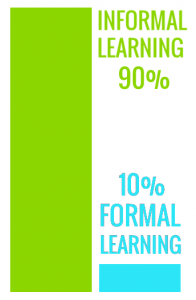 Whenever you roll out a training plan, you need to think about what ‘success’ looks like. In online learning terms, these metrics might include how many people are using your Learning Management System (LMS) on a daily or weekly basis, how long they’re spending on it, how much work they’re doing whilst there and what they think about their LMS.
Whenever you roll out a training plan, you need to think about what ‘success’ looks like. In online learning terms, these metrics might include how many people are using your Learning Management System (LMS) on a daily or weekly basis, how long they’re spending on it, how much work they’re doing whilst there and what they think about their LMS.
Good Learning Management Systems, by their very nature, capture a lot of data that can help to highlight whether learners are engaged or not. This data can map learner engagement and even pinpoint learners that are at risk of falling behind or failing.
Here are 5 learner engagement metrics, available from your LMS, that will help you work out whether your learners are engaged or not:
Learner Engagement Metric 1: Recency
How recently have you seen your learners logging on to their LMS? Is this number stable, decreasing, or growing?
If your LMS is new, perhaps you had an initial surge of learners logging on almost every minute in the early days, but you’re noticing this number tapering off now to one per hour or so. Should you be worried? Well, not always. There will always be an increase in interest when a new training programme is launched – learners are curious, so will naturally want to take a look. It’s the number after this point that will need to be monitored. If the recency is dropping from hourly, to daily, to weekly, it’s likely that there is an issue with your LMS – it might not be engaging your learners.
Learner Engagement Metric 2: Frequency
 How often does each learner log on? You’ll be able to monitor the average frequency of learners, which can tell you whether you have a small number of learners logging on frequently, whether there are a couple of extremely dedicated learners logging on enough to skew the results, or if you’ve hit upon a comfortable, stable average.
How often does each learner log on? You’ll be able to monitor the average frequency of learners, which can tell you whether you have a small number of learners logging on frequently, whether there are a couple of extremely dedicated learners logging on enough to skew the results, or if you’ve hit upon a comfortable, stable average.
A stable average with a few outliers is what you should be aiming for – a small number of learners logging on frequently does not necessarily mean that they are adequately engaged.
Indeed, the link between frequency and engagement is not entirely clear at all. If the trend shows that the most successful learners logged onto their LMS most frequently, does that mean they were the most engaged? Perhaps – but it’s not completely clear. Maybe they simply had to log on more times to complete training because they didn’t progress through the whole eLearning module in one go? This would actually imply they were less engaged than their fellow learners who logged on fewer times, but got more done during each session!
 Learner Engagement Metric 3: Duration
Learner Engagement Metric 3: Duration
The above problem is why it’s also important to monitor duration. How long are learners actually staying on their LMS, and what are they doing?
Given that social learning is so important to actually cement training in learners’ minds, the duration data will need to be considered carefully. It’s actually not as useful for learners to spend 99% of their time in eLearning modules – we gain only 10% of our knowledge from ‘formal’ training, after all, so the ideal ratio of activity might be closer to that suggested by the ’70:20:10 problem’ (read: What is leaky knowledge costing your organisation?).
Therefore an ideal duration split might be closer to spending 10% of their time in eLearning units, and 90% on forums, in groups, downloading extra reading materials and chatting with others.
Learner Engagement Metric 4: Virility
Has your LMS ‘gone viral’ within your organisation? Has word spread about how great it is, how fun it is to use and how useful it is in boosting performance and improving prospects?
A solid marketing plan, both pre- and post-launch, can aid this. If employees are excited about the training, counting down the days until launch and can’t wait to try it out, the virility of the training will be significantly higher than if it suddenly appears in employees’ inboxes with no fanfare.
 Learner Engagement Metric 5: Rating
Learner Engagement Metric 5: Rating
When you ask learners what they think of their LMS, what do they say? Do they say it’s the best thing since sliced bread, or are they more reticent in revealing their thoughts?
Don’t overlook the effect of reporter bias, which is the idea that respondents might only answer questions with answers they think you’ll want to hear. Also, be wary of asking leading questions. The question, “This LMS is much better than the classroom training you had before, right?” won’t really tell you anything. Instead, asking learners to anonymously rank and rate their LMS will be more revealing.
These metrics – and others – are useful in telling you how successful your LMS is and how engaged your learners might be. You’ll need to take them all into account, as you can’t rely on just one or two to give you a proper indication of learner engagement. After all, without knowing how your employees are rating the LMS, how can you be sure it’s going viral for the right reasons? And if you can’t monitor how long your learners are staying logged in, the number of logins is all but meaningless.
Learner engagement metrics will be useful in working out the return on investment on your training programme. To make sure you’re achieving the right ROI for you, download our free white paper below:






